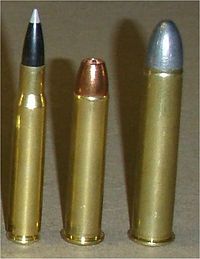.45-70 Government
| .45-70 Government | ||||||||||||||||||||
|---|---|---|---|---|---|---|---|---|---|---|---|---|---|---|---|---|---|---|---|---|

From left, .30-06, .45-70, and .50-90 Sharps
|
||||||||||||||||||||
| Type | Rifle | |||||||||||||||||||
| Place of origin | United States | |||||||||||||||||||
| Service history | ||||||||||||||||||||
| Used by | United States | |||||||||||||||||||
| Wars | American Indian Wars | |||||||||||||||||||
| Production history | ||||||||||||||||||||
| Designer | US Government | |||||||||||||||||||
| Designed | 1873 | |||||||||||||||||||
| Specifications | ||||||||||||||||||||
| Case type | Rimmed, tapered | |||||||||||||||||||
| Bullet diameter | .458 in (11.6 mm) | |||||||||||||||||||
| Neck diameter | .480 in (12.2 mm) | |||||||||||||||||||
| Base diameter | .505 in (12.8 mm) | |||||||||||||||||||
| Rim diameter | .608 in (15.4 mm) | |||||||||||||||||||
| Rim thickness | .070 in (1.8 mm) | |||||||||||||||||||
| Case length | 2.105 in (53.5 mm) | |||||||||||||||||||
| Overall length | 2.550 in (64.8 mm) | |||||||||||||||||||
| Rifling twist | 1-20" | |||||||||||||||||||
| Primer type | Large rifle | |||||||||||||||||||
| Ballistic performance | ||||||||||||||||||||
|
||||||||||||||||||||
|
Test barrel length: 24" Source(s): Accurate Powder |
||||||||||||||||||||
The .45-70 rifle cartridge, also known as . 45-70 Government, was developed at the U.S. Army's Springfield Armory for use in the Springfield Model 1873, which is known to collectors as the "trapdoor Springfield". The new cartridge was a replacement for the stop-gap .50-70 Government cartridge which had been adopted in 1866, one year after the end of the American Civil War.
The new cartridge was completely identified as the .45-70-405, but was also referred to as the ".45 Government" cartridge in commercial catalogs. The nomenclature of the time was based on three properties of the cartridge:
The minimum acceptable accuracy of the .45-70 from the 1873 Springfield was approximately 4 inches (100 mm) at 100 yards (91 m), however, the heavy, slow-moving bullet had a "rainbow" trajectory, the bullet dropping multiple yards (meters) at ranges greater than a few hundred yards (meters). A skilled shooter, firing at known range, could consistently hit targets that were 6 × 6 feet (1.8 m) at 600 yards (550 m)—the army's standard target. It was a skill valuable mainly in mass or volley fire, since accurate aimed fire on a man-sized target was effective only to about 300 yards (270 m).
After the Sandy Hook tests of 1879, a new variation of the .45-70 cartridge was produced: the .45-70-500, which fired a heavier, 500 grain, (32.5 g) bullet. The heavier bullet produced significantly superior ballistics, and could reach ranges of 3,350 yards (3,120 m), which were beyond the maximum range of the .45-70-405. While the effective range of the .45-70 on individual targets was limited to about 1,000 yards (915 m) with either load, the heavier bullet would produce lethal injuries at 3,500 yards (3,200 m). At those ranges, the bullets struck point-first at a roughly 30 degree angle, penetrating three 1-inch (2.5 cm) thick oak boards, and then traveling to a depth of 8 inches (20 cm) into the sand of the Sandy Hook beach. It was hoped the longer range of the .45-70-500 would allow effective volley fire at ranges beyond those normally expected of infantry fire.
...
Wikipedia
